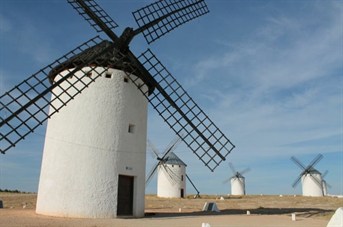The giants of La Mancha: Don Quixote and the windmills
 “What giants?” – said Sancho Panza – “Those you see there – said his master – with long arms, some of them nearly two leagues long.” “Look, your grace – replied Sancho – the ones that you see there are not giants but windmills, and what seem arms are actually blades, moved by the wind, that turn the stone mill.” (Don Quijote de la Mancha, Part I, Chapter VIII).
“What giants?” – said Sancho Panza – “Those you see there – said his master – with long arms, some of them nearly two leagues long.” “Look, your grace – replied Sancho – the ones that you see there are not giants but windmills, and what seem arms are actually blades, moved by the wind, that turn the stone mill.” (Don Quijote de la Mancha, Part I, Chapter VIII).
Don Quijote was certainly not wrong in defining his powerful enemies, the windmills, as giants, given their enormous size. Even today you can see these big machines that were used to grind corn and draw the necessary flour to make bread in the typical landscape of La Mancha. It is a tool that dates back to the ancient Mediterranean (probably Greco-Roman, but there are other theories that assert Arab, Chinese or even twelfth century Central European origins), but the current form of the windmills of La Mancha are from the Baroque period, when the highest number of windmills placed on top of the hills of the region was recorded. During the long periods of drought experienced by the region of La Mancha during the sixteenth and seventeenth centuries, the use of wind and the building of mills became the perfect combination to be able to eat. The construction was based on a stone cylinder topped by a cone-shaped covering in straw or wood. Inside there were three floors, one where to keep the ground wheat , the other where to lay the instruments of the mill, the third and highest was full of small windows through which the wind passed, so as to allow the miller to understand from which side the wind was blowing. The grinding action and a number of mechanisms which regulated movement were critical in to grind the cereal. Outside, the impulse of the wind was captured by large canvases (now lost, as you can see in the photo) stretched above the blades. On the opposite side to that of the blades was placed the palo de gobierno, that moved the roof and the blades depending on the direction of the wind.
Cervantes wanted to immortalize them in his work, when Don Quijote, with his spear, fighting desperately against these buildings, thought that they were enemies eager to attack him. Scattered throughout much of the territory of La Mancha, you can now visit the mills dating from the sixteenth and seventeenth century in different urban centers in the region such as Campo de CriptanaCampo de Criptana is a town in the province of Ciudad Real in the Community of Castilla la Mancha. There are archeological remains from the Neolithic Age and testimonies of the Reconquista conducted by the Order of Santiago, but without a doubt the seventeenth century was the period of the greatest cultural evolution of the town. Cervantes was inspired by its fields of grain and its windmills as the setting for one of the most famous episodes of his Don Quijote. (Ciudad Real), where today there are a total of 10 mills, of which 3 are from the the sixteenth and seventeenth centuries and have retained the original mechanisms (image). A few kilometers to Alcázar de San Juan (Ciudad Real), there are 4 restored mills. At Madridejos (Toledo), there is only one old mill, dating back to the sixteenth century within the town and not on a hill as usual. At Consuegra (Toledo) 12 mills remain in good condition, high on a hill.
